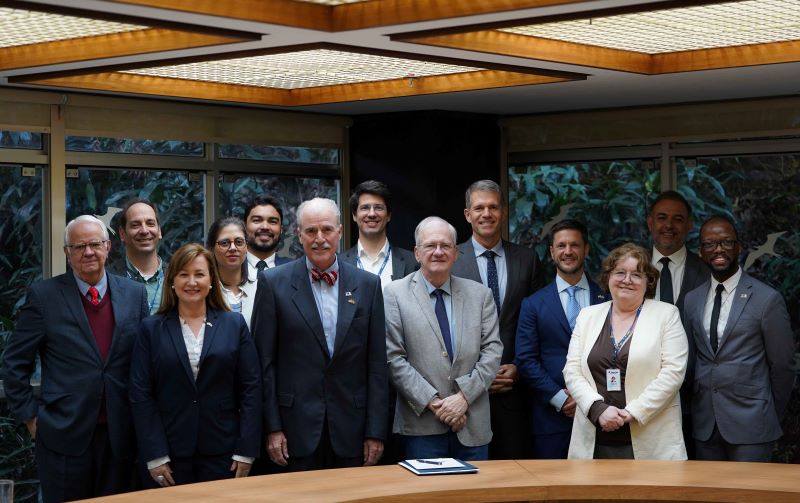

Peter Kilmarx and Marco Antonio Zago signed the renewed MoU at FAPESP on August 15 (photo: Daniel Antônio/Agência FAPESP)
The MoU is the first cooperation agreement between NIH and a foreign partner to cover a wide array of research areas.
The MoU is the first cooperation agreement between NIH and a foreign partner to cover a wide array of research areas.

Peter Kilmarx and Marco Antonio Zago signed the renewed MoU at FAPESP on August 15 (photo: Daniel Antônio/Agência FAPESP)
By Elton Alisson | Agência FAPESP – FAPESP and the National Institutes of Health (NIH), an arm of the United States Department of Health and Human Services, signed a renewed memorandum of understanding (MoU) on August 15.
According to Dr. Peter Kilmarx, Deputy Director of the Fogarty International Center at NIH, this is the first cooperation agreement between the world’s leading public funder of biomedical and behavioral health science and a foreign partner to cover a wide array of research areas.
“This is my first visit to Brazil, about which I’ve always heard that it’s an important research partner for NIH. And it really is one of the countries we most cooperate with. More than 200 NIH-funded collaborations are under way between US and Brazilian scientists, on various topics but above all infectious diseases. We're very pleased to be here, renewing and strengthening the memorandum of understanding between our two institutions,” Kilmarx said during his visit to FAPESP.
The purpose of FAPESP’s cooperation arrangement with NIH, which dates from 2014, is to encourage scientists affiliated with universities and research institutions in São Paulo State and the US to submit joint research proposals.
Marco Antonio Zago, President of FAPESP, stressed that the MoU has now been renewed in order to intensify and broaden cooperation in biomedical and behavioral health research between researchers in São Paulo and the US.
“Institutional cooperation with NIH hasn’t been as strong as we would have liked in recent years, but even so researchers based in São Paulo have a long history of research collaboration with the US institution. We expect that now [with renewal of the MoU], this cooperation will increase,” he said.
Kilmarx explained that NIH is the primary US federal agency conducting and supporting basic, clinical, and translational medical research on common and rare diseases in terms of their causes, treatment and cure, both intramurally (within its own labs and clinics) and extramurally (via grants to support programs outside NIH).
The institution has 27 research centers and institutes that employ over 6,000 scientists, 83 of whom are Brazilians, and receive about 10% of its annual budget, which totals more than USD 47 billion. “Fifteen of these 27 research centers and institutes currently have some 40 collaborations with Brazil,” Kilmarx said.
In addition to its support for intramural research, NIH funds the work and training of more than 400,000 scientists and technical research support staff in over 2,500 institutions, including universities, medical schools, hospitals and institutes located in the US and several other countries, he noted.
NIH receives some 80,000 applications for funding per year on average, and selects 45,000. “Support for extramural research accounts for about 81% of NIH’s budget,” he said.
Cross-border collaboration
China is the country with the most research collaborations with NIH, Kilmarx said during an event hosted on August 16 by the University of São Paulo’s Medical School (FM-USP) to discuss strategies for intensifying cross-border collaboration.
Brazil had the most co-authors of scientific articles published by researchers affiliated with NIH between 2009 and 2017, followed by the United Kingdom, Canada and Germany. In 2017, 35% of all publications funded by NIH had a co-author not affiliated with a US institution, according to Kilmarx. “Brazil has the most articles co-authored with NIH among middle-income countries,” he said.
NIH is interested in funding biomedical research in Brazil for several reasons, Kilmarx said. One is the unique genetics of its populations and the discoveries about infectious diseases that Brazil has made in recent years.
“Everything we needed to learn about zika virus, for example, was here. Thanks to rapid building of very strong research collaborations, we were able to learn that the disease causes microcephaly and is also sexually transmitted,” he said during the event.
Zago highlighted São Paulo State’s robust infrastructure for health research, which is conducted at universities, public and private hospitals, and centers such as Butantan Institute.
“Roughly 40% of the articles published by researchers affiliated with universities and research institutions in São Paulo State have foreign co-authors, 23% of them in the US,” he said.
Also attending the event to renew the MoU with NIH were Kevin Bialy, Regional Program Director, Fogarty International Center; Richard Glenn, US Consul General in São Paulo; Darryl Turner, Consul for Economic Affairs, Environment, Science, Technology and Health; Dailani Carrijo, Public Health Analyst, US Department of Health and Human Services; and Renan Silva, Economic Specialist, ESTH (Environment, Science, Technology and Health), US Consulate General in São Paulo.
FAPESP was represented by Professor Zago and Concepta McManus Pimentel, the Scientific Directorate’s Manager of Research Collaboration; Leandro Colli, an advisor to the Scientific Director; and Raul Machado, an advisor to the President.

(foto: Daniel Antônio/Agência FAPESP)
Republish
The Agency FAPESP licenses news via Creative Commons (CC-BY-NC-ND) so that they can be republished free of charge and in a simple way by other digital or printed vehicles. Agência FAPESP must be credited as the source of the content being republished and the name of the reporter (if any) must be attributed. Using the HMTL button below allows compliance with these rules, detailed in Digital Republishing Policy FAPESP.





